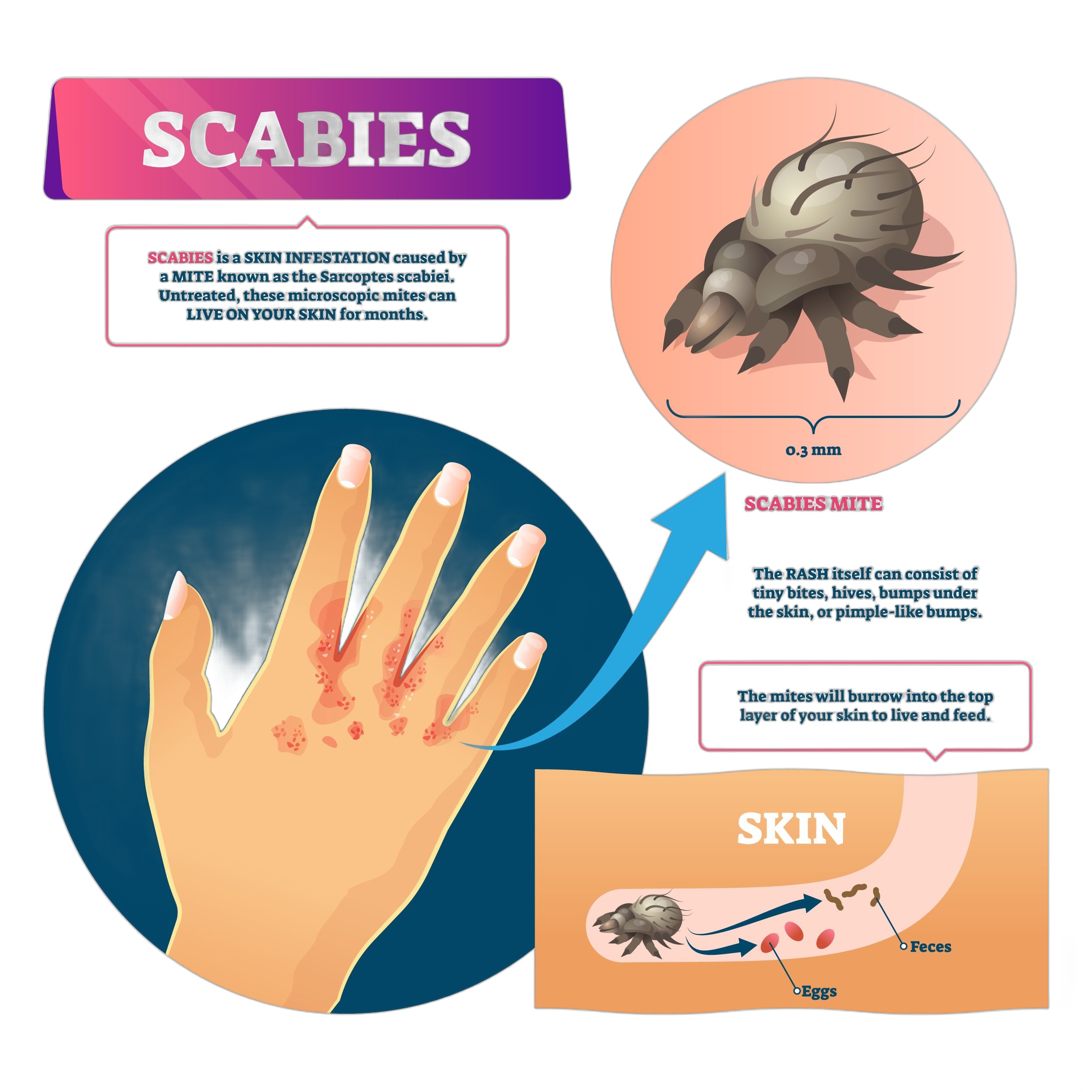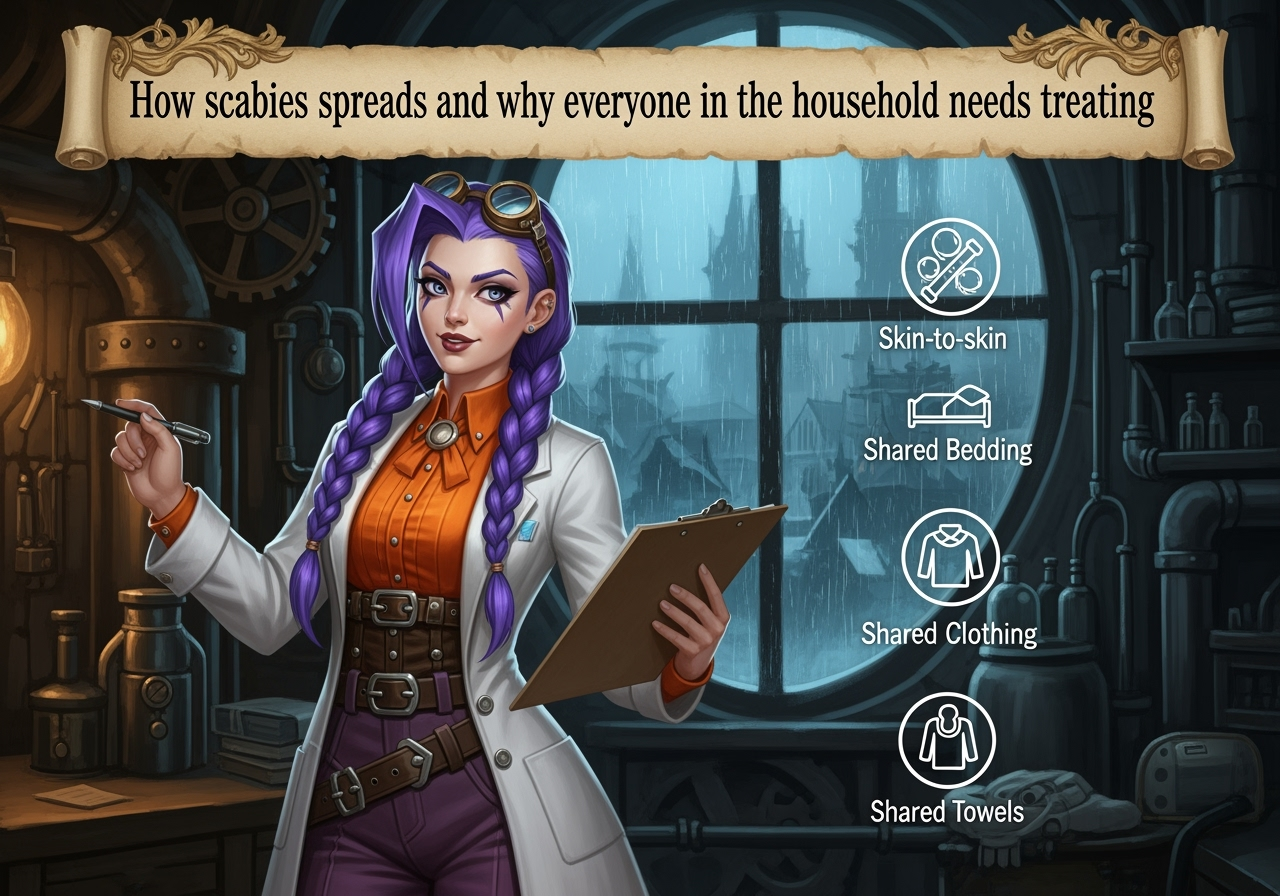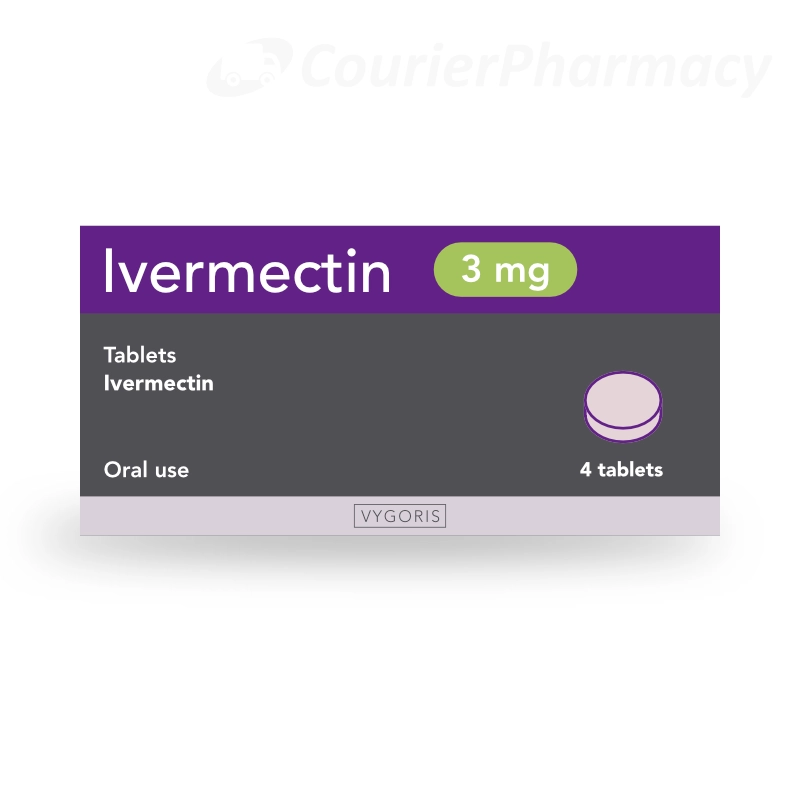Find the right scabies treatment for you
View All ProductsWhat you should know about scabies
It’s a skin infestation caused by the mite Sarcoptes scabiei. Only 10–15 mites are needed to cause an infection.
Usually 4–6 weeks for first infections, but just 1–4 days if you’ve had scabies before.
The itching is an allergic reaction to the toxins released by mites and their waste, not the mites themselves.
Yes, everyone in close contact should be treated at the same time.
No, the human scabies mite only infects humans. Animal mites (mange) don’t survive long on people.
Wash items on a hot cycle. Mites die after 2–3 days off human skin.
It’s spread by prolonged skin contact. Brief contact is low risk, but sharing a bed or having sex is high risk.
Additional information
Scabies
This guide covers everything you need to know about scabies: what it is, how it spreads, its symptoms, diagnosis, treatment options, prevention tips, and answers to the most common questions. We’ve made it clear, trustworthy, and friendly, so whether you’re a patient, a carer, or just curious, you’ll find practical advice and expert insight here.
- Scabies is a contagious skin condition caused by tiny mites that burrow into the skin.
- The main symptoms are intense itching and a distinctive rash, which often gets worse at night.
- Diagnosis is usually made by a healthcare professional based on the rash and burrows.
- Effective treatments include permethrin cream and oral ivermectin, but everyone in close contact needs to be treated too.
- Preventing reinfection means treating contacts and cleaning bedding and clothing.

What is scabies?
Scabies is a skin condition caused by tiny mites called Sarcoptes scabiei. These mites burrow into the skin’s outer layer and lay their eggs. Within three to four days, these eggs hatch, producing mites that then return to the skin surface, where they mature to continue the life cycle. If this life cycle is not broken, then it will continue indefinitely.
This burrowing of the mite causes intense itching and a rash that can keep you up at night.
The scabies mite prefers a warm climate, which is why it is found in areas of the body such as:
- Skin folds,
- Between the fingers and toes,
- Around the buttocks, and
- Breast creases
Scabies spreads mainly through prolonged, close skin-to-skin contact, such as hugging, holding hands, or sharing bedding and towels.
The mites can’t jump or fly, so casual contact is less risky. Scabies is more common in winter when people spend more time indoors together. It can affect anyone, regardless of age or hygiene [1][2][3].

Symptoms of scabies
Symptoms usually start 4–6 weeks after first being infected, but if you’ve had scabies before, symptoms can appear in just a few days.
The classic sign is intense itching, especially at night. The rash appears as small, red spots, sometimes accompanied by tiny blisters.
You may also see burrow marks—thin, wavy, silver-grey lines with a dot at one end. Common sites for adults include between the fingers and toes, wrists, elbows, armpits, waist, buttocks, and genitals. In children and older adults, the scalp, face, and soles of the feet can also be affected [1][2].

Where scabies affects the body
In adults, scabies mites often leave tiny burrow marks in certain areas, including:
- Between the fingers and toes
- In and around skin folds
- Around the genitals (in men)
- Around the nipples (in women)
- On the sides and soles of the feet
- Around the elbows and wrists
The scabies rash can appear almost anywhere on the body except the head. The most common places are:
- Lower buttocks
- Groin area
- Female genital area
- Under the arms
- Inside of the elbows
- Around the waist
- Knees, lower legs, and ankles
- Across the shoulder blades
In infants, young children, and older adults, scabies may affect areas not usually seen in healthy adults, such as:
- The neck, face, and scalp
- The palms of the hands and soles of the feet

How is scabies diagnosed?
Most people can be diagnosed by a healthcare professional simply by examining the rash and burrows.
Sometimes, a skin scraping may be taken and looked at under a microscope to confirm the diagnosis.
If you think you have genital scabies or your partner has been diagnosed, visit a sexual health clinic for a proper check and advice [2][4].

Treatment options for scabies
The main goal is to kill the mites and their eggs. The most commonly used treatment is permethrin cream, which is applied to the entire body (except the face and scalp in adults) and left on for at least 8 hours before being washed off.
A repeat application is usually required after 7 days.
Oral ivermectin is sometimes prescribed, especially for crusted or resistant scabies, or if creams aren’t practical [5][6].
It’s essential to treat everyone in your household and close contacts simultaneously, even if they don’t exhibit symptoms. Otherwise, the infection can continue to circulate.

Treating the scabies itch
Anti-itch creams, such as crotamiton (Eurax), and antihistamines, such as hydroxyzine, can help alleviate symptoms, but won’t kill the mites [1].
When treating the intense itch caused by scabies, hydroxyzine can be a helpful option.
Scabies mites trigger an allergic-type skin reaction that often causes severe, persistent itching, which may continue even after the mites are treated.
Hydroxyzine is an antihistamine with sedating properties that helps reduce the itch by blocking histamine, a chemical released during the immune response.
It can also make it easier for patients to rest at night, when itching is usually worst. While hydroxyzine does not kill the mites themselves, it plays a vital role in improving comfort and preventing complications such as skin damage from scratching, which could lead to secondary infections.
Treatment should always be combined with a prescribed scabicide, and hydroxyzine is generally used for short-term relief under medical supervision.

Preventing reinfection
To stop scabies coming back:
- Treat all household members and close contacts at the same time, even if they feel fine.
- Wash clothes, bedding, and towels used in the three days before treatment on a hot wash and dry thoroughly.
- Things you can’t wash, like shoes or soft toys, can be sealed in a plastic bag for at least three days.
- Avoid close contact with others until treatment is complete [1][2].

How to deal with scabies mites on clothes and bedding
Do:
- Wash clothes, bedding, and towels in a hot wash to kill mites.
- Leave items that can’t be washed in a sealed bag for at least 3 days – mites die without human skin.
- Treat everyone in the household at the same time to stop the mites from spreading back and forth.
Don’t:
- Share clothes, towels, or bedding until treatment is finished.
- Assume quick contact (like a handshake) will spread scabies – the risk is very low.
- Ignore prolonged contact – sleeping with, hugging, or having sex with someone infected carries a high risk, and treatment is usually needed.

When to seek urgent care
See a doctor urgently if you have:
- Severe spreading redness, swelling, or pain
- Red streaks running up your limb or swollen lymph nodes
- Fever (temperature above 38°C) or feel very unwell
- Numbness, loss of sensation, or your digit turning blue/black
These can be signs that the infection is spreading or becoming serious [1][2].
Disclaimer: This article is for informational purposes only and does not replace professional medical advice.
References
- NHS (2023) Scabies. Available at: https://www.nhs.uk/conditions/scabies/ (Accessed: 30 September 2025).
- NICE Clinical Knowledge Summary (2025) Scabies. Available at: https://cks.nice.org.uk/topics/scabies/ (Accessed: 30 September 2025).
- Fernando, D.D. et al. (2024) ‘Scabies’, Nature Reviews Disease Primers, 10(1), p.74.
- NICE Clinical Knowledge Summary (2025) Management of scabies. Available at: https://cks.nice.org.uk/topics/scabies/management/management-of-scabies/ (Accessed: 30 September 2025).
- BNF (2025) Permethrin: indications and dose. Available at: https://bnf.nice.org.uk/drugs/permethrin/#indications-and-dose (Accessed: 30 September 2025).
- NICE Clinical Knowledge Summary (2025) Ivermectin: prescribing information. Available at: https://cks.nice.org.uk/topics/scabies/prescribing-information/ivermectin/ (Accessed: 30 September 2025).
BSc Pharmacy, Independent Prescriber, PgDip Endocrinology, MSc Endocrinology, PgDip Infectious Diseases
Superintendant Pharmacist, Independent Prescriber
BSc Pharmacy
Compounding Pharmacist



